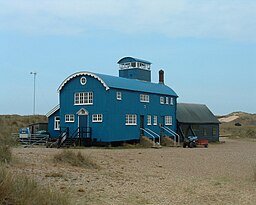Blakeney Point
| Blakeney Point | |
| National Nature Reserve | |
|
The visitor centre, formerly a lifeboat station
|
|
| Official name: Blakeney Point Nature Reserve | |
| Country | England |
|---|---|
| County | Norfolk |
| District | North Norfolk |
| Coordinates | 52°58′38″N 0°58′40″E / 52.9772°N 0.9778°ECoordinates: 52°58′38″N 0°58′40″E / 52.9772°N 0.9778°E |
| Biome | Salt marsh and mudflats |
| Geology | Shingle ridge spit |
| Animal | Migrating and nesting birds, seals |
| Management | National Trust |
| Owner | National Trust |
| For public | Open all year |
| Protection | SSSI, SAC, SPA, Ramsar Site and AONB |
| IUCN | IUCN category IV (habitat/species management area) |
| Website: National Trust Blakeney Point | |
Blakeney Point (designated as Blakeney National Nature Reserve) is a National Nature Reserve situated near to the villages of Blakeney, Morston and Cley next the Sea on the north coast of Norfolk, England. Its main feature is a 6.4 km (4 mi) spit of shingle and sand dunes, but the reserve also includes salt marshes, tidal mudflats and reclaimed farmland. It has been managed by the National Trust since 1912, and lies within the North Norfolk Coast Site of Special Scientific Interest, which is additionally protected through Natura 2000, Special Protection Area (SPA), International Union for Conservation of Nature (IUCN) and Ramsar listings. The reserve is part of both an Area of Outstanding Natural Beauty (AONB), and a World Biosphere Reserve. The Point has been studied for more than a century, following pioneering ecological studies by botanist Francis Wall Oliver and a bird ringing programme initiated by ornithologist Emma Turner.
The area has a long history of human occupation; ruins of a medieval monastery and "Blakeney Chapel" (probably a domestic dwelling) are buried in the marshes. The towns sheltered by the shingle spit were once important harbours, but land reclamation schemes starting in the 17th century resulted in the silting up of the river channels. The reserve is important for breeding birds, especially terns, and its location makes it a major site for migrating birds in autumn. Up to 500 seals may gather at the end of the spit, and its sand and shingle hold a number of specialised invertebrates and plants, including the edible samphire, or "sea asparagus".
...
Wikipedia


